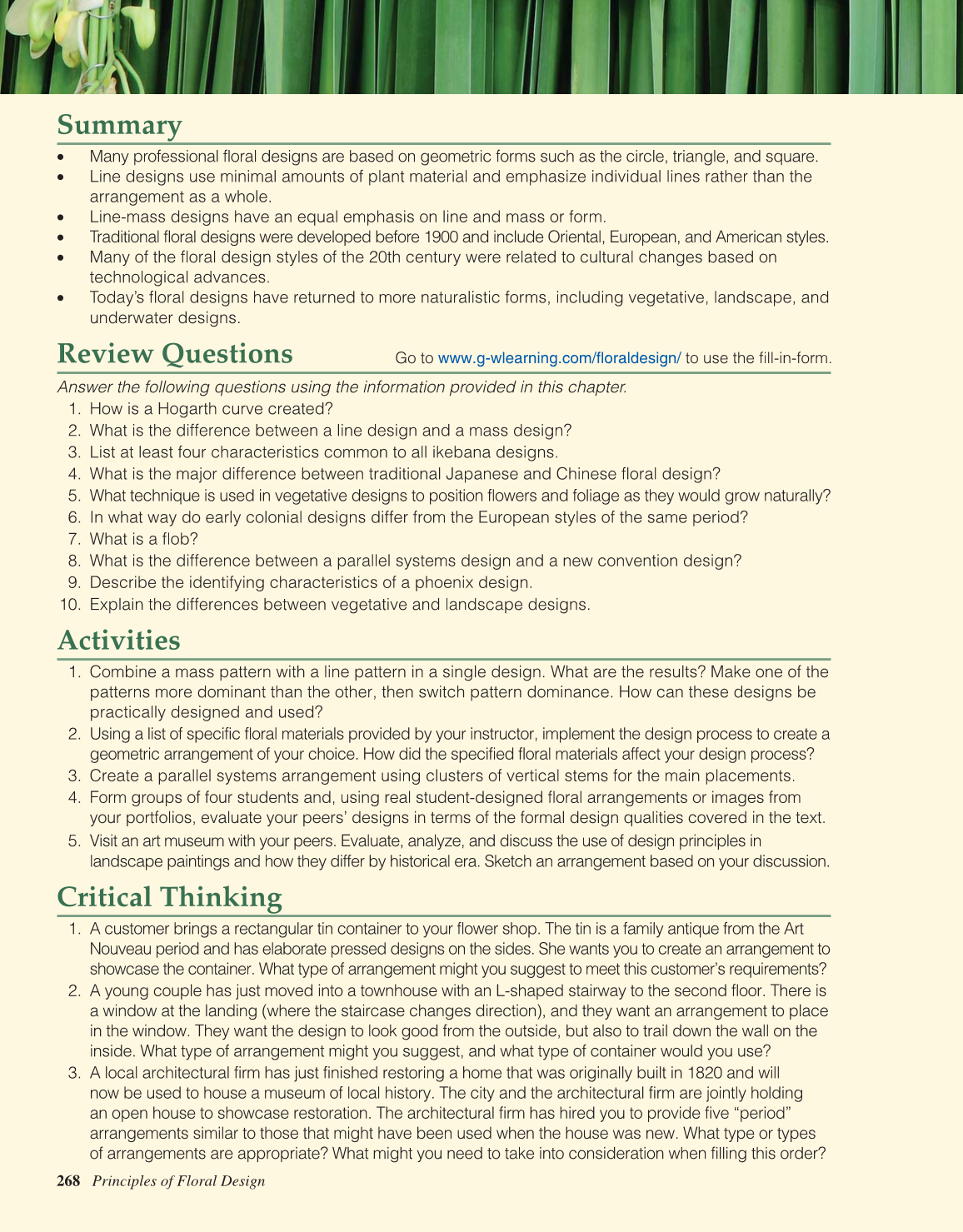268 Principles of Floral Design
Summary
• Many professional floral designs are based on geometric forms such as the circle, triangle, and square.
• Line designs use minimal amounts of plant material and emphasize individual lines rather than the
arrangement as a whole.
• Line-mass designs have an equal emphasis on line and mass or form.
• Traditional floral designs were developed before 1900 and include Oriental, European, and American styles.
• Many of the floral design styles of the 20th century were related to cultural changes based on
technological advances.
• Today’s floral designs have returned to more naturalistic forms, including vegetative, landscape, and
underwater designs.
Review Questions
Answer the following questions using the information provided in this chapter.
1. How is a Hogarth curve created?
2. What is the difference between a line design and a mass design?
3. List at least four characteristics common to all ikebana designs.
4. What is the major difference between traditional Japanese and Chinese floral design?
5. What technique is used in vegetative designs to position flowers and foliage as they would grow naturally?
6. In what way do early colonial designs differ from the European styles of the same period?
7. What is a flob?
8. What is the difference between a parallel systems design and a new convention design?
9. Describe the identifying characteristics of a phoenix design.
10. Explain the differences between vegetative and landscape designs.
Activities
1. Combine a mass pattern with a line pattern in a single design. What are the results? Make one of the
patterns more dominant than the other, then switch pattern dominance. How can these designs be
practically designed and used?
2. Using a list of specific floral materials provided by your instructor, implement the design process to create a
geometric arrangement of your choice. How did the specified floral materials affect your design process?
3. Create a parallel systems arrangement using clusters of vertical stems for the main placements.
4. Form groups of four students and, using real student-designed floral arrangements or images from
your portfolios, evaluate your peers’ designs in terms of the formal design qualities covered in the text.
5. Visit an art museum with your peers. Evaluate, analyze, and discuss the use of design principles in
landscape paintings and how they differ by historical era. Sketch an arrangement based on your discussion.
Critical Thinking
1. A customer brings a rectangular tin container to your flower shop. The tin is a family antique from the Art
Nouveau period and has elaborate pressed designs on the sides. She wants you to create an arrangement to
showcase the container. What type of arrangement might you suggest to meet this customer’s requirements?
2. A young couple has just moved into a townhouse with an L-shaped stairway to the second floor. There is
a window at the landing (where the staircase changes direction), and they want an arrangement to place
in the window. They want the design to look good from the outside, but also to trail down the wall on the
inside. What type of arrangement might you suggest, and what type of container would you use?
3. A local architectural firm has just finished restoring a home that was originally built in 1820 and will
now be used to house a museum of local history. The city and the architectural firm are jointly holding
an open house to showcase restoration. The architectural firm has hired you to provide five “period”
arrangements similar to those that might have been used when the house was new. What type or types
of arrangements are appropriate? What might you need to take into consideration when filling this order?
Go to www.g-wlearning.com/floraldesign/ to use the fill-in-form.
